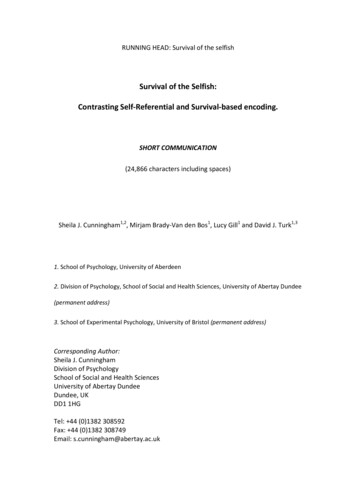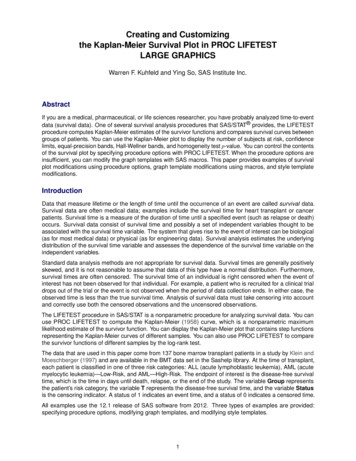
Transcription
LESSONbackgroundinformation2TOOLS FOR SURVIVALAFRICAN CAT ADAPTATIONSEducator’s Background InformationStrength, elegance, power, and speed – no wonder lionsand cheetahs are considered some of the most beautifulanimals on Earth! The physical characteristics that makethem so stunning to watch are more than just for looks.They provide them with the tools to hunt and survive lifeon the savanna.Staying AliveDrought, heat, rain, sun, predators, rocks, and harsh terrain:life on the savanna isn’t easy!Fortunately, lions and cheetahs have special physical andbehavioral characteristics or adaptations that allow themto survive in this beautiful, yet harsh environment.These include: The cheetah’s spots and the lion’s sandy color help themhide and stalk prey in the savanna’s tall grasses. A strong sense of smell, excellent hearing, and fantasticvision help them find prey and avoid conflicts withother predators. A cheetah can spot prey from as far as3 miles away! Sensitive whiskers help them navigate through theirenvironment, especially at night by detecting changesin air currents. Roughly as wide as the cat’s body andsensitive to pressure, these whiskers also act as natural“rulers” by helping them determine the size of an openingbefore they get stuck. Dark “tear stains” below the cheetah’s eyes. Unlike mostAfrican predators, cheetahs hunt during the day. Thesemarkings may act like sunglasses, reducing glare anddirecting sunlight away from the cheetah’s eyes. The male lion’s thick mane helps it look bigger andprotects its throat when fighting off predators. The lion’s famous roar. These and other loud vocalizationsallow them to communicate to other pride members, call outterritories, and warn off other lions from long distances. Theroar of an adult male lion can be heard up to five miles away! The quiet chirp of the solitary cheetah helps itcommunicate to its cubs without drawing the attentionof lions, hyenas, and other larger, stronger predators. 2010 Disney Enterprises, Inc.Physical differences actually prevent the cheetah frombeing able to roar like other large African cats.Adaptations for HuntingCheetahs and lions are spectacular hunters. As predators,they have special adaptations to catch, kill, and eat their prey: Long tails help them balance and steer during the hunt. Padded, textured paws provide protection from rocksand thorns and better traction for running and hunting. Sharp, pointed teeth are used to bite and hold preyand tear meat from the bone. Rough tongues act like sandpaper, helping them scrapeevery bit of meat from the bones of their prey. If you haveever been licked by a house cat you know how rough theirtongue can be! Eyes positioned in the front of their head (binocularvision) give them depth perception and the ability tojudge distances when stalking or chasing prey.Different Cats Different Strategies:Strength vs. SpeedWhile both cheetahs and lions are amazing athletes,each have different adaptations designed to support theirdifferent hunting strategies.The Cheetah: A Speedy, Solitary HunterCheetahs are like track stars, with every part designed forspeed. When they spot prey, they can accelerate from 0 to 60mph in only three seconds. That’s faster than most cars!How is this possible? Long legs, a flexible collar bone, and aspringy backbone that bends in both directions help cheetahstake long, ground-covering strides. A cheetah moving at topspeed can cover over 20 feet in a single stride! The bones ona cheetah’s feet and legs are specially adapted to take thepounding of a hard run. Like other cats, cheetahs run on theirtoes. This makes it easier for them to make sudden turnswithout losing their balance.Like cleats on a track shoe, the cheetah’s long claws helpthem grip the ground as they run.14
LESSONbackgroundinformation2AfricanTools forCatSurvival:Adaptations:AfricanToolsCat Adaptationsfor Survival cont’dcont’dUnlike those of other cats, the claws of a cheetah are alwaysextended. In fact, cheetahs are the only cats that can’t fullyretract their claws (their claws are semi-retractable).A lean, muscular build and smaller head makes the cheetahstrong, yet lightweight and streamlined. Enlarged nostrils,heart, lungs, liver, and sinuses provide their muscles with theextra oxygen and blood they need to function at top speeds.All these adaptations help the cheetah to stretch further, takelonger strides, and run faster than any other land mammal.At full speed a cheetah can run 70 mph for short distancesand cover an amazing 92 feet in a single second!Unfortunately, the very same adaptations that make thecheetah the fastest land animal also make it less able todefend itself and its food from other predators. The jaws ofa cheetah are not as large and strong as many other Africancarnivores. Because of this, cheetahs would rather flee thanfight, and they often lose their hard won meals to lions,leopards, hyenas, and even vultures.The African Lion: Dominance through Powerand NumbersIf the cheetah is the sprinter of the animal world, the lion ismore like a wrestler, using its power and strength to grab and 2010 Disney Enterprises, Inc.pull down prey. Unlike cheetahs, lions usually hunt at night,when they use their exceptional hearing, tan camouflagedcoloration, stealth, and strength to locate, stalk, and ambushtheir prey. Using their powerful, heavily muscled front legsand shoulders, a lion can knock down a full grown zebra orstun a large antelope simply with a blow to the head orhindquarters with their massive forepaws. Unlike the cheetah,the lion’s impressive claws are retractable, which allow themto stay sharp for hunting. A lion’s large, sharp canine teeth areshaped like steak knives and are used for biting, holding ontoits prey, and tearing large chunks of meat. A lion’s loose bellyskin helps it avoid injury if kicked by prey during a hunt.Unlike the usually solitary cheetah, lions find strength innumbers. They are the only species of cat that live and huntin groups. These groups, or “prides”, usually consist of oneresident male (or even two to three brothers), along with acore of related females (mothers, sisters, cousins, and aunts)and their cubs. The males help the females protect the pridewhile the females do most of the hunting. Hunting as a groupincreases their opportunity to stalk and ambush more preyand to hunt much larger prey than a single lion ever could.Lions have even been known to attack elephants when otherprey is scarce!15
LESSONbackgroundinformationTools for Survival: African Cat Adaptations cont’d2Lion Fact SheetCheetah Fact SheetThe lion is the most powerful carnivore on the Africansavanna. Physical characteristics of the lion help it catchand take down prey. Female lions hunt in groups, whichhelps them take down large prey such as zebra, antelope,Cape buffalo, and giraffe.The cheetah lives on the savannas of Africa. It is a largepredator like other members of the cat family. Physicalcharacteristics of the cheetah help it to hunt and catch preyat very fast speeds, making it the world’s fastest landmammal. It is lacking power and strength in exchangefor speed and agility.Eyes Binocular vision and large eyes provide excellenteyesight. Binocular vision allows a lion to correctlyjudge distance when stalking prey. Excellent night vision helps a lion hunt. Lionsand people see equally well during the day, buta lion’s night vision is six times more powerfulthan human eyesight.Ears A lion relies heavily on its acute hearingwhen hunting. Lions rotate and move their ears constantly for bettersound location of prey when hunting.Teeth Large, sharp canine teeth help catch and kill prey. Scissor-like molars, or carnassials, are used to ripoff chunks of flesh from prey. A lion’s tongue is rough and covered with tinyhooks called papillae that help to scrape flesh offthe bones of prey. Powerful jaws help a lion grab and kill prey quickly.Bones Has strong front legs and muscular shoulders thathelp knock down large prey that might otherwiseoutrun the lion.Fur Solid tan fur helps a lion blend or camouflage intall grass when stalking prey.Tail Has a long, powerful tail to help with balance.Legs Has short but strong, sturdy legs that enable alion to sprint and catch large prey.Feet Padded paws increase traction while running andallow a silent approach.Claws Has long, curved claws, like fish hooks, to graband hold prey. Able to retract super sharp claws to protect themfrom getting worn down while walking. Retractableclaws are quieter and make it easier to surprise prey.Eyes Has fantastic vision that helps the cheetah spot preyas far as 3 miles (5 km) away. Binocular vision and large eyes provide excellenteyesight. Binocular vision allows a cheetah tocorrectly judge distance when stalking and chasingprey, making sight its most important sense. The dark tear marks below the eyes may help keepthe sun’s glare out of the eyes, similar to sunglasses.Ears Has excellent hearing which helps a cheetah huntfor prey. Rounded ears are reduced in size to help makethe cheetah’s head more streamlined.Nose Wide nostrils increase oxygen while running.Teeth Sharp teeth are designed to catch and kill prey.Bones Has a flexible spine which helps a cheetah stretch outfurther and take longer strides when running.Body Has a streamlined body shape that is long and thinwith a small head which helps a cheetah run faster. Has very deep chest with a large heart and lungswhich pump blood and oxygen to the muscles atquick speeds.Fur Tawny coat with round black spots helps it blend intograsses and breaks up a cheetah’s silhouette, makingit easier to hide from other predators and stalk prey.Tail Has a long strong tail that helps with balancewhen running quickly and making sharp turns.Legs Has long thin legs that allow for longer strides whenrunning. Long legs help a cheetah quickly accelerate upto 60 mph in 3 seconds.Feet Padded paws increase traction while running.Claws Has semi-retractable claws that help grip the groundwhile running, similar to sports cleats. 2010 Disney Enterprises, Inc.16
LESSONactivityone2Tools for Survival: African Cat AdaptationsCAN YOU BECOME ANAFRICAN CAT OLYMPIAN?Setting: Classroom Grade: 2–6 Length of Activity: 1 hour Subjects: Science Staff: At least one teacher or volunteer(additional staff may be helpful for running multiple activities or class management)DESCRIPTIONMATERIALSTo strengthen their connection with lions and cheetahs,students will test their cat-like skills in several games thatmake up the African Cat Olympics. These games encouragethe use of kinesthetic learning to provide an engagingexperience focused on the behaviors and adaptations ofAfrican cats. African cats such as lions and cheetahs haveunique physical adaptations that make them top predatorsin their environment.Lion’s Leap Worksheet #7: Lion’s Leap Paws-a-gram Measuring tape Masking tape or sidewalk chalkOBJECTIVESThrough participation in this activity students will: Understand the terms adaptation and competition. Distinguish between a predator and prey. Describe two examples of lion and cheetah adaptations. Become “African Cat Athletes” by using imagination, play,and movement to learn about physical adaptations ofAfrican cats.POSITIVE ACTIONS TO HELP AFRICAN CATSThanks to their amazing adaptations, lions and cheetahs aretop predators on the African savanna. Learn more aboutlions and cheetahs by reading books and visiting websiteslisted in the educator’s guide.SAFE PRACTICESMake sure the field or schoolyard is safely prepared forstudent activity. Be sure to check for any trip hazards orsharp objects that could be dangerous for students. 2010 Disney Enterprises, Inc.Cheetah Relay Race Sunglasses (1 pair for each station) Spotted t-shirt or coat (1 for each station) Sneakers or soccer cleats (1 pair for each station) Baton (or decorated paper towel roll) (1 for each station) Masking tape or sidewalk chalkSavanna Competitors (Capture the Flag game) 2 “prey” items – flags with prey cut-outs or an animal figurine Rope, masking tape, or sidewalk chalk Worksheet #8: African Cat Athlete Award Certificates –one for each studentSET UPLion’s Leap Make copies and cut out the Lion’s Leap Paws-a-gram pageso that there is one paw print for each student. Set this activity up in a large open space, preferably outdoors(a grassy field, basketball court, or recess yard work best). Use masking tape or chalk to mark a starting line on the ground.From this starting line, use a measuring tape to mark off eachfoot up to 20 feet (the distance a lion can leap horizontally). Label each tick mark to make reading measurements easierduring the activity.(continued on the next page)17
LESSONCAN YOU BECOME AN AFRICAN CAT OLYMPIAN? (2 of 4)Cheetah Relay Race Use a large open space, preferably outdoors (a grassy field,basketball court, or recess yard work best). For a class of 30, set up 5 stations. Use masking tape or chalk tomark a starting line and a return line for each station. Use masking tape or sidewalk chalk to create a “balancing line”between the start and return points at each station. Place the following items in a box at each starting line:- Sunglasses- Spotted t-shirt or coat- Sneakers/soccer cleats After set-up is complete, the field should look similar to thefield diagram below.STARTSTARTSTARTSTARTSTART 2010 Disney Enterprises, Inc.Savanna Competitors (Capture the Flag game) Use a large open space, preferably outdoors (a grassy field,basketball court, or school yard work best). Use rope, masking tape, or sidewalk chalk to mark adividing line between opposite ends of the field. Decorate two flags: one with images of a lion’s prey(zebra, giraffe, warthog, etc.), and the other with imagesof a cheetah’s prey (Thomson’s gazelle, helmeted guineafowl, springbok, etc). Print out and personalize the African Cat Athlete AwardCertificate for each student.RETURN RETURN2RETURN RETURN RETURNactivityoneTools for Survival: African Cat Adaptations18
LESSONactivityone2Tools for Survival: African Cat AdaptationsCAN YOU BECOME AN AFRICAN CAT OLYMPIAN? (3 of 4)ProceduresIntroduction1. Introduce students to the term adaptation. Have studentsbrainstorm a list of adaptations that help animals survive.They may list physical adaptations such as powerful legs,webbed feet, or large wings. They may list behavioraladaptations as well, such as caring for young or alion’s roar.2. Ask students the following questions to encourage themto draw their own conclusions about adaptations beforebeginning the activity: Explain in your own words why adaptations areimportant. Both physical and behavioral adaptationscan offer protection from predators, allow animals toaccess food more easily, or help them camouflage intheir surroundings. What adaptations do people have to help them survive?Create a T-gram to compare animals to humans. Lungs,legs, skin, eyes, ears, hair, arms, hands, thumbs, nose,the five senses, and our family groups are all examplesthat the students may list. What are some adaptations that lions and cheetahsmight have that help them survive? For a list of lionand cheetah adaptations, refer to the Educator’sBackground Information for this section.3. Introduce the terms predator and prey. Have studentslist and categorize examples of predators and prey on theAfrican savanna. Ask students where lions and cheetahsfit into these categories. Create connections by asking students how and whyadaptations are important to predators like lions andcheetahs.4. After completing the class discussion, inform students theywill have the opportunity to test their skills against theadaptations of a lion and a cheetah in the African CatOlympics.Lion’s Leap1. In this activity, they will be testing how far theycan leap compared to a lion.2. First ask students to predict how far they think alion can leap.3. Then, have the class line up single file at the start line. 2010 Disney Enterprises, Inc.Instruct the first student in line to stand upright in astationary position with both feet on the starting line.4. Have each student jump as far as they can, one at atime. Record the distance they jumped on their Lion’sLeap Paws.5. Next, have the student continue to jump, each time froma stationary position, until they reach the 20 foot tickmark. Record the number of jumps it took for the studentto reach the end of the line.Cheetah Relay Race1. Take the students outside into the field or area that youhave safely prepared and carefully monitor their activitywhile outdoors. Be sure that the area and students aresafe. For a class of 30, divide the class into five teams ofsix students.2. For each team, have three students line up behindthe “start” line and three students line up behind the“return” line.3. Once all teams have assembled, explain the followingsteps of the relay race:a. To begin the race, the first person at the “start” line(student #1) must put on sunglasses and cross thefield, walking the straight line with one foot in front ofthe other. Once they reach the “return” line, they mustraise their “paws” and chirp like a cheetah to signal theperson at the “return” line (student #2) to go. Student#2 must take the glasses and walk the straight line backto the “start” line.b. Student #2 raises their “paws” and chirps to signalstudent #3 to go. Student #3 must put on the spottedt-shirt and do a “cheetah crouch” to cross the field(both hands and feet touching the ground). Once theyreach the “return” line, student #3 passes the spottedt-shirt to student #4, who puts the t-shirt on over theirown clothes, and signals them to cross the field alsodoing a “cheetah crouch”.c. When student #4 reaches the “start” line, they signalstudent #5 by picking up the baton from the supplybox and chirping as they hand it off. Student #5 mustput on the tennis shoes/soccer cleats and race acrossthe field to student #6. Once there, they should passoff the shoes and baton with a chirp, signaling student#6 to cross the field one last time. When student #6crosses the “start” line, the relay race is complete.19
LESSONactivityone2Tools for Survival: African Cat AdaptationsCAN YOU BECOME AN AFRICAN CAT OLYMPIAN? (4 of 4)4. The objective of the game is to successfully complete allsteps of the relay race in the least amount of time. Thefirst team to bring student #6 across the “start” line will bedeclared the winner.Savanna Competitors (Capture the Flag game)1. Now tell students they will test their skills as either a lionor a cheetah by playing a game where they will compete,as lions or cheetahs, for space and food.2. Ensure the safety of students by preparing an outside fieldor area and monitoring their activity. Divide the class intotwo teams, lions and cheetahs.3. Each team has its own home range, divided by the linedown the middle of the field. Students are free to movearound their home range, but are in danger if theycross into the other team’s home range. If a cheetahcrosses into lion home range they may be capturedand vice versa.4. Have both teams assemble at the dividing line but withintheir own home range. Choose a team leader for eachside and give them their prey item.5. On a signal, the team leader sets their prey item near theend of field. The prey item must be visible to the otherteam. Players may guard their prey item but cannot touchor hold onto the prey item while guarding it.6. Once the team leaders have placed their prey item,another signal is given for the start of the game. Studentscan then enter the other team’s home range in an attemptto steal the prey item. Once on the other team’s homerange, however, students are at risk of being tagged out.Once a player is tagged out, they are out for the rest ofthe game and may sit near the side of the field.7. To win the game, a team must capture the prey item andbring it back into their home range without being tagged.If neither side catches the enemy’s prey item within a settime limit (15-20 minutes), the team with the most 2010 Disney Enterprises, Inc.individuals left in the game is declared the winner.Wrap-upUse the discussion points below to review the purpose of theAfrican Cat Olympics with your students: Describe the lion and cheetah adaptations you used in eachof the Olympic “events”. Conclude how these adaptationsare useful for life on the savanna. Students mimicked thelion’s ability to leap, and the cheetah’s claws, black undereye marks, long tail for balance, and speed. All of theseare useful because they help lions and cheetahs catch preyand fulfill their role as top predators on the savanna. Thinking about the Savanna Competitors game, explainhow home range and population size affect lions andcheetahs in the wild. Both lions and cheetahs require alarge home range. This means that each individual orgroup of individuals needs ample space to roam. Thelarger the lion and cheetah population, the more spacethat is required. If the population increases but the spacestays the same or decreases, this causes competitionbetween individuals and species. Imagine you are a cheetah on the savanna. How does thepresence of a lion pride in your home range affect you?Cheetahs would typically rather flee than fight. Becauseof this, the presence of a lion pride would likely forcethe cheetah to move elsewhere.African cats such as lions and cheetahs have unique physicaladaptations that make them top predators in theirenvironment.EvaluationTo evaluate student comprehension, have students correctlyanswer the corresponding lesson questions on the Big Ideasfor Big Cats card and then place it on the bulletin board in itsproper location.20
LESSONactivityone2worksheet 5Tools for Survival: African Cat AdaptationsLION’S LEAP PAWS-A-GRAMNAME:NAME:LIONS CAN LEAP 20 FEET IN ONE JUMP!LIONS CAN LEAP 20 FEET IN ONE JUMP!I leapedIt tookfeet in one jump.jumps to reach 20 feet.I leapedIt tookfeet in one jump.jumps to reach 20 feet.TELL ALL YOUR FRIENDS HOW AMAZING LIONS ARE!TELL ALL YOUR FRIENDS HOW AMAZING LIONS ARE!NAME:NAME:LIONS CAN LEAP 20 FEET IN ONE JUMP!LIONS CAN LEAP 20 FEET IN ONE JUMP!I leapedIt tookfeet in one jump.jumps to reach 20 feet.TELL ALL YOUR FRIENDS HOW AMAZING LIONS ARE! 2010 Disney Enterprises, Inc.I leapedIt tookfeet in one jump.jumps to reach 20 feet.TELL ALL YOUR FRIENDS HOW AMAZING LIONS ARE!21
LESSONactivityone2worksheet 6 2010 Disney Enterprises, Inc.Tools for Survival: African Cat AdaptationsAFRICAN CAT ATHLETE AWARD CERTIFICATE22
lions and cheetahs by reading books and visiting websites listed in the educator's guide. SAFE PRACTICES Make sure the field or schoolyard is safely prepared for student activity. Be sure to check for any trip hazards or sharp objects that could be dangerous for students. MATERIALS Lion's Leap Worksheet #7: Lion's Leap Paws-a-gram








![[ST] Survival Analysis - Stata](/img/33/st.jpg)


